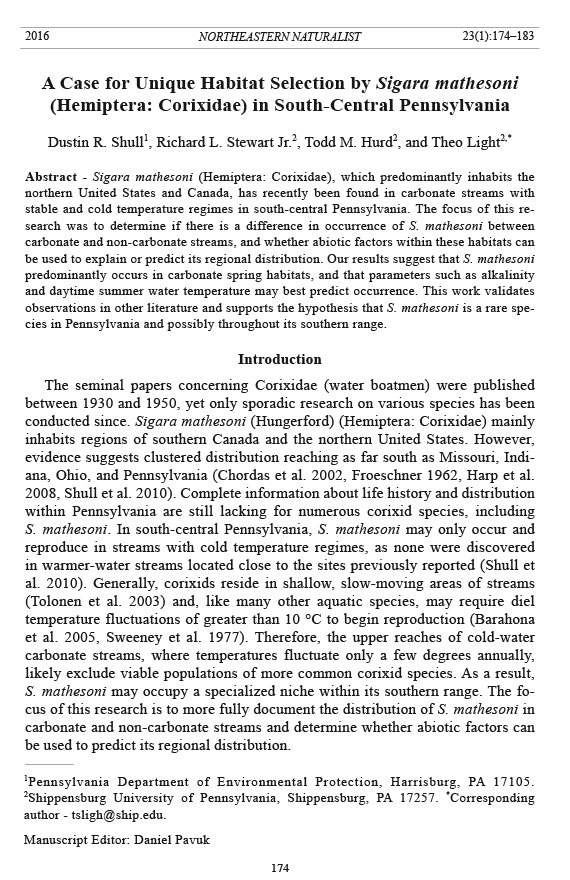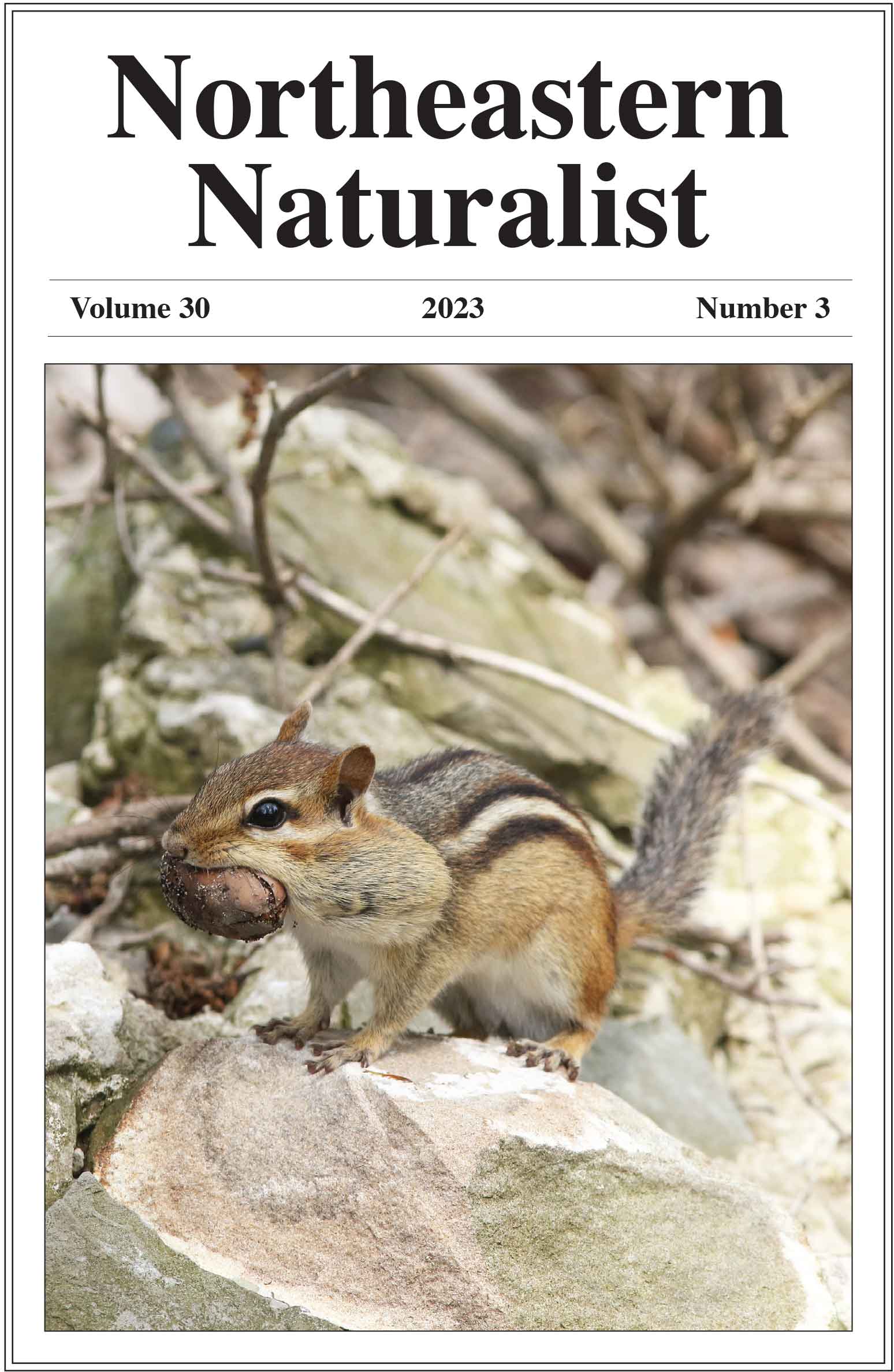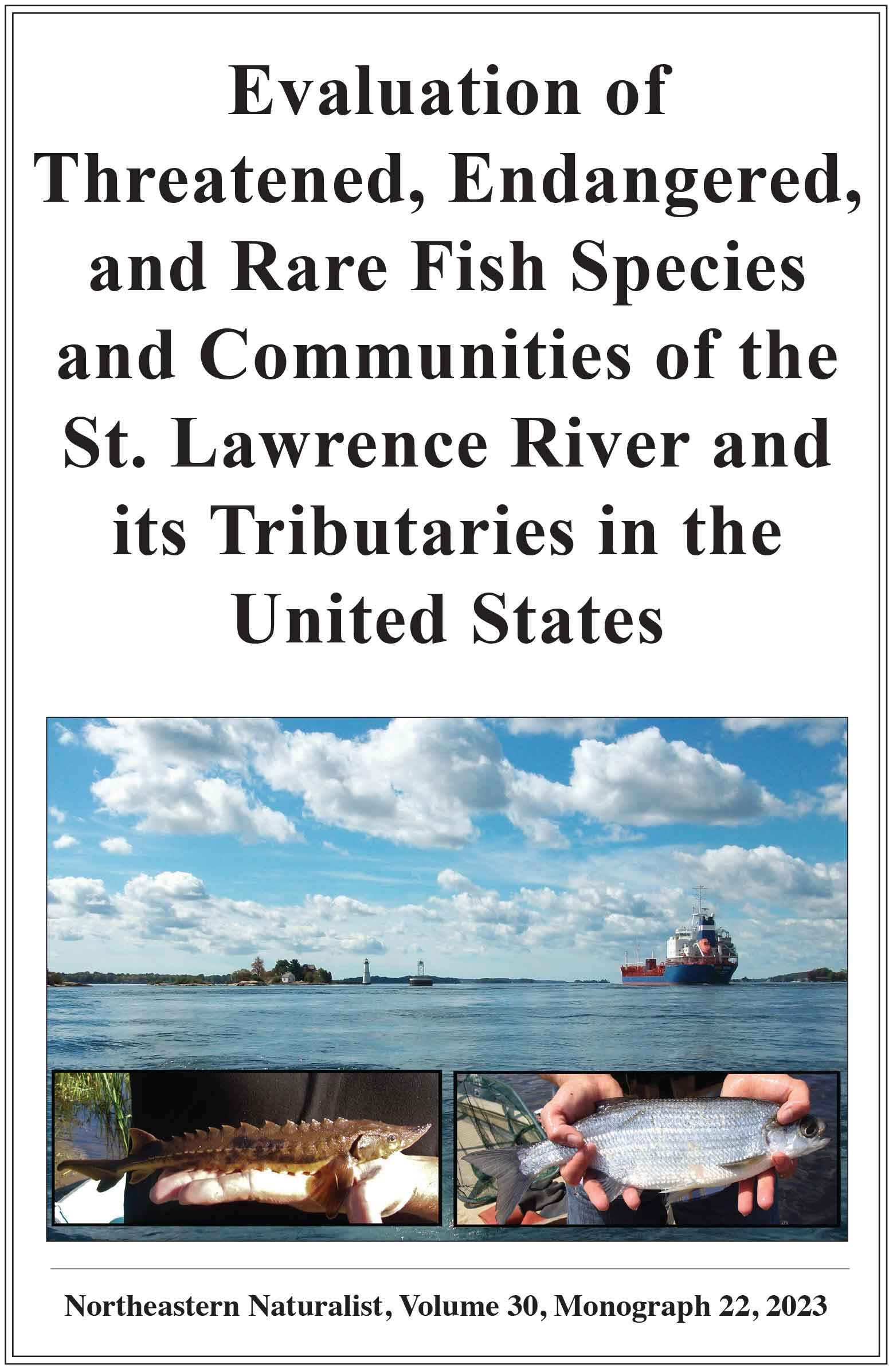A Case for Unique Habitat Selection by Sigara mathesoni (Hemiptera: Corixidae) in South-Central Pennsylvania
Dustin R. Shull, Richard L. Stewart Jr., Todd M. Hurd, and Theo Light
Northeastern Naturalist, Volume 23, Issue 1 (2016): 174–183
Full-text pdf (Accessible only to subscribers. To subscribe click here.)

Access Journal Content
Open access browsing of table of contents and abstract pages. Full text pdfs available for download for subscribers.
Current Issue: Vol. 30 (3)

Check out NENA's latest Monograph:
Monograph 22









Northeastern Naturalist
174
D.R. Shull, R.L. Stewart Jr., T.M. Hurd, and T. Light
22001166 NORTHEASTERN NATURALIST 2V3(o1l). :2137,4 N–1o8. 31
A Case for Unique Habitat Selection by Sigara mathesoni
(Hemiptera: Corixidae) in South-Central Pennsylvania
Dustin R. Shull1, Richard L. Stewart Jr.2, Todd M. Hurd2, and Theo Light2,*
Abstract - Sigara mathesoni (Hemiptera: Corixidae), which predominantly inhabits the
northern United States and Canada, has recently been found in carbonate streams with
stable and cold temperature regimes in south-central Pennsylvania. The focus of this research
was to determine if there is a difference in occurrence of S. mathesoni between
carbonate and non-carbonate streams, and whether abiotic factors within these habitats can
be used to explain or predict its regional distribution. Our results suggest that S. mathesoni
predominantly occurs in carbonate spring habitats, and that parameters such as alkalinity
and daytime summer water temperature may best predict occurrence. This work validates
observations in other literature and supports the hypothesis that S. mathesoni is a rare species
in Pennsylvania and possibly throughout its southern range.
Introduction
The seminal papers concerning Corixidae (water boatmen) were published
between 1930 and 1950, yet only sporadic research on various species has been
conducted since. Sigara mathesoni (Hungerford) (Hemiptera: Corixidae) mainly
inhabits regions of southern Canada and the northern United States. However,
evidence suggests clustered distribution reaching as far south as Missouri, Indiana,
Ohio, and Pennsylvania (Chordas et al. 2002, Froeschner 1962, Harp et al.
2008, Shull et al. 2010). Complete information about life history and distribution
within Pennsylvania are still lacking for numerous corixid species, including
S. mathesoni. In south-central Pennsylvania, S. mathesoni may only occur and
reproduce in streams with cold temperature regimes, as none were discovered
in warmer-water streams located close to the sites previously reported (Shull et
al. 2010). Generally, corixids reside in shallow, slow-moving areas of streams
(Tolonen et al. 2003) and, like many other aquatic species, may require diel
temperature fluctuations of greater than 10 °C to begin reproduction (Barahona
et al. 2005, Sweeney et al. 1977). Therefore, the upper reaches of cold-water
carbonate streams, where temperatures fluctuate only a few degrees annually,
likely exclude viable populations of more common corixid species. As a result,
S. mathesoni may occupy a specialized niche within its southern range. The focus
of this research is to more fully document the distribution of S. mathesoni in
carbonate and non-carbonate streams and determine whether abiotic factors can
be used to predict its regional distribution.
1Pennsylvania Department of Environmental Protection, Harrisburg, PA 17105.
2Shippensburg University of Pennsylvania, Shippensburg, PA 17257. *Corresponding
author - tsligh@ship.edu.
Manuscript Editor: Daniel Pavuk
Northeastern Naturalist Vol. 23, No. 1
D.R. Shull, R.L. Stewart Jr., T.M. Hurd, and T. Light
2016
175
Field Site Description
The Great Valley and nearby areas within south-central Pennsylvania (Franklin
and Cumberland counties) were chosen based on the density of carbonate streams.
These cold-water carbonate streams are rare compared to the more common noncarbonate
streams of Pennsylvania (approximately 800 vs. 86,000 stream miles,
respectively; Botts 2009). Carbonate-stream distribution is clustered in certain
regions of PA with geology rich in limestone and dolomite. The Ordovician and
Cambrian formations of the Great Valley are representative of such geological
characteristics (Becher and Root 1981). In Pennsylvania, Ordovician and Cambrian
formations stretch from lower Franklin County northeast to Northampton County.
There are also smaller deposits concentrated in Centre, Mifflin, Adams, York, and
Lancaster counties, PA (DCNR 2007).
Hungerford (1948) reported the occurrence of S. mathesoni in the vicinity of
3 Pennsylvanian towns: State College (21 November 1938), Bethlehem (14 May
1912), and Wyomissing (27 August1934). All of these observations, as well as those
of Shull et al. (2010) at Big Spring Creek, fall within the Ordovician and Cambrian
carbonate formations. This distribution may suggest that abiotic stream characteristics
such as alkalinity, conductivity, and water temperature can predict the regional
distribution of S. mathesoni. Prior research based on stream observations and geologic
distribution also supports this hypothesis (Chordas et al. 2002). However,
Chordas et al. (2002) focused on documenting new species in Indiana, Michigan,
Ohio, and Pennsylvania, and did not record abiotic conditions. It’s important to note
that not all streams that fall within carbonate geology are classified as carbonate
streams (Botts 2009). Therefore, certain parameters must be established to distinguish
between the 2 stream types.
Methods
For this study, 2 different stream types (carbonate and non-carbonate) were chosen
to compare the differences in S. mathesoni occurrence. We selected carbonate
stream sites based on the carbonate criteria described by Botts (2009), where alkalinity
must be at or above 140 mg/L CaCO3, stream temperature must remain around
4–18 °C year round, and stream size must be small (drainage area less than 50 km2)
with little to no surface-water inputs. Specifically, we sampled 9 carbonate streams
and 11 non-carbonate streams (Table 1) throughout south-central Pennsylvania. For
simplicity, we classified sites that were determined to be carbonate influenced (having
most, but not all carbonate characteristics) as non-carbonate.
We collected specimens using a truncated D-framed net with 500-micron mesh.
The sampling process at each site consisted of 20 jabs (~1 m long) into aquatic vegetation
and sediment, focusing on the best available habitat for corixids (Tolonen et
al. 2003). We conducted species identification of S. mathesoni in the field using a
10x field lens to observe the distinct presence of a longitudinal brown stripe in the
intraocular space (Hungerford 1948), and took vouchers from each site for verification.
We then determined relative abundance of nymphal and adult S. mathesoni for
Northeastern Naturalist
176
D.R. Shull, R.L. Stewart Jr., T.M. Hurd, and T. Light
2016 Vol. 23, No. 1
Table 1. Sampling results of 9 carbonate and 11 non-carbonate streams in south-central Pennsylvania that were sampled for Sigara mathesoni (S. m.).
Specific
Site Stream Ambient DO conductance Alkalinity S. m. Other
code Stream name Stream type temp (°C) temp (°C) (mg/L) pH (μS/cm @ 25°C) (mg/L CaCO3) total Corixidae
C1 Big Spring Creek Carbonate 12.1 29.0 10.50 7.49 491 135 28 No
C2 Alexander Spring Creek Carbonate 12.0 26.7 10.05 7.42 640 186 1 Yes
C3 Hogestown Run Carbonate 18.1 30.0 12.23 7.93 627 164 2 Yes
C4 Letort Spring Run Carbonate 12.4 29.4 10.67 7.63 570 160 0 Yes
C5 Trout Run Carbonate 14.7 28.9 10.04 7.85 583 148 2 No
C6 Green Spring Creek Carbonate 15.4 32.2 9.65 7.53 688 191 7 Yes
C7 Mount Rock Spring Carbonate 12.2 32.2 10.70 7.46 612 171 52 Yes
C8 Middle Spring Creek Carbonate 15.5 31.0 12.02 7.96 368 102 391 Yes
C9 Falling Spring Creek Carbonate 13.3 29.4 11.80 7.64 620 179 3 No
N1 Birch Run Non-carbonate 17.8 29.0 9.36 4.98 17 1 0 No
N2 Conewago Creek Non-carbonate 20.7 24.0 9.09 7.33 76 27 0 Yes
N3 Conodoguinet Creek Non-carbonate 22.1 29.0 9.33 7.26 82 21 0 No
N4 Mountain Creek Non-carbonate 24.4 29.0 8.50 6.44 47 16 0 No
N5 Muddy Run Non-carbonate 16.1 22.0 8.63 7.85 638 218 12 Yes
N6 Opossum Creek Non-carbonate 20.3 24.0 9.17 7.37 129 29 0 No
N7 Plum Run Non-carbonate 22.9 26.0 8.83 7.62 503 161 0 Yes
N8 Reservoir Hollow Run Non-carbonate 21.4 29.0 8.52 6.40 78 27 0 No
N9 Rocky Mountain Creek Non-carbonate 23.7 30.0 8.55 7.34 106 25 0 No
N10 South Branch Conodoguinet Non-carbonate 21.3 29.0 10.66 6.90 57 18 0 No
N11 West Branch Conococheague Non-carbonate 20.8 28.0 8.60 7.98 459 164 0 No
Northeastern Naturalist Vol. 23, No. 1
D.R. Shull, R.L. Stewart Jr., T.M. Hurd, and T. Light
2016
177
each site. Sampling occurred during July and August when late instars and adults
of S. mathesoni were most likely to co-occur. The presence of adults and late instars
indicated an established population as well as potential reproduction. We also
recorded the occurrence of other corixid species at each site, but did not identify to
species or count for relative abundance those specimens.
We field-measured 5 physicochemical parameters at each site: water temperature,
conductivity, and pH with an Oakton® CON 6 digital meter; dissolved oxygen
with a YSI® model 550A digital meter; and alkalinity with the Hach® model 16900
digital titrator. Although we sampled only once at each site, we took all water temperature
readings near mid-day (1100–1500 hours) in July or August, so they were
representative of some of the highest annual temperatures in each stream.
Data were analyzed using R version 3.1.2 software (R Core Team 2015). We
conducted a Fisher’s exact test to determine if there was an overall difference
between S. mathesoni and other corixid occurrences in carbonate versus noncarbonate
streams. To determine which physiochemical factors were most closely
associated with the presence of S. mathesoni, we employed logistic regression and
information-theoretic model selection using AICc (Burnham and Anderson 2002).
We developed a set of candidate models that included all possible linear combinations
of 1–3 of the 5 water-quality parameters, excluding combinations of highly
correlated (r > 0.75) measures. The only excluded combination was of alkalinity
and specific conductance (r = 0.98). A global model containing all 5 parameters was
also included. Using the R package AICcmodavg (Mazerolle 2013), we ranked all
candidate models based on AICc values, and based inference on a confidence set of
the top-ranked models.
Results
We found a total of 486 S. mathesoni in 8 of 9 carbonate streams and 12 in 1 of 11
non-carbonate streams (Table 1, Fig. 1). Sigara mathesoni occurrence was strongly
associated with carbonate-classified streams (Fisher’s exact test: P < 0.001). Other
corixids were also more frequently observed in carbonate streams (Table 1), but
differences in occurrence between the 2 stream types were not significant (Fisher’s
exact test: P = 0.17).
Model selection resulted in a large number of similarly ranked models that had
similar predictive ability (Table 2). Seven models had delta AICc values of ~2 or
below, and of these, all the 2-parameter models had predictive success of 90 or 95%
(most misclassified only the Letort Spring Run, predicting S. mathesoni would be
present in the one carbonate stream in which it was not found). The most successful
models typically included a combination of specific conductance, alkalinity or pH,
along with either daytime summer water temperature or dissolved oxygen (Table 2).
The models predicted presence of S. mathesoni in sites with alkalinity above 100
mg/L as CaCO3, and daytime summer water temperatures 18 °C or below, consistent
with the definition of a carbonate stream (Fig. 2). Other corixids did not show a
consistent relationship with these 2 parameters (Fig. 2).
Northeastern Naturalist
178
D.R. Shull, R.L. Stewart Jr., T.M. Hurd, and T. Light
2016 Vol. 23, No. 1
Discussion
This study clarifies several characteristics of S. mathesoni distribution in southcentral
Pennsylvania. Sigara mathesoni does occur with much greater frequency
in carbonate streams than non-carbonate streams, and their presence in this small
Figure 1. Sampling locations and geographic distribution of positive and negative S. mathesoni
occurrence in carbonate and non-carbonate streams. Sites are labeled with individual
site code shown in Table 1.
Table 2. Ninety-five percent confidence set of models predicting presence/absence of S. mathesoni. All
models are logistic regression models built using the glm() function in R, with family set to binomial and
the link function to “logit”. Models were ranked using the AICcmodavg package (Mazerolle 2013).
Model parameters K AICc ΔAICc AICc weight Predictive success
cond+DO 3 15.999 0.000 0.164 0.95
alk+DO 3 16.322 0.323 0.140 0.95
cond 2 16.962 0.963 0.101 0.85
cond+temp 3 17.272 1.273 0.087 0.90
pH+temp 3 17.525 1.527 0.077 0.95
temp 2 17.809 1.810 0.066 0.90
alk+temp 3 18.035 2.037 0.059 0.95
cond+pH+DO 4 18.950 2.951 0.038 0.95
cond+temp+DO 4 19.068 3.070 0.035 0.95
alk+temp+DO 4 19.187 3.188 0.033 0.95
cond+pH+temp 4 19.431 3.432 0.030 0.95
alk+pH+DO 4 19.463 3.464 0.029 0.95
temp+DO 3 19.596 3.598 0.027 0.90
cond+pH 3 19.618 3.619 0.027 0.80
alk 2 19.843 3.844 0.024 0.80
alk+pH+temp 4 20.179 4.180 0.020 0.95
Northeastern Naturalist Vol. 23, No. 1
D.R. Shull, R.L. Stewart Jr., T.M. Hurd, and T. Light
2016
179
sample can be predicted accurately using combinations of any of a number of commonly
measured water-quality parameters. Specific conductance and dissolved
oxygen were the best indicators for S. mathesoni occurrence in this dataset, but may
not be as reliable across a more diverse set of streams. For example, specific conductance
can be high in streams for reasons other than the presence of a carbonate
influence, such as a forested headwater stream with acid mine drainage. Dissolved
oxygen can vary a great deal within sites, and can undergo major diel fluctuations
in productive sites, even those with quite stable temperatures. Alkalinity and daytime
summer water temperature make the most sense as parameters to predict the
Figure 2. Presence and
absence of S. mathesoni
and other corixids
in relationship to
alkalinity and daytime
summer water temperature.
Northeastern Naturalist
180
D.R. Shull, R.L. Stewart Jr., T.M. Hurd, and T. Light
2016 Vol. 23, No. 1
occurrence of S. mathesoni, as these are the 2 most important parameters for distinguishing
between carbonate and non-carbonate streams (Botts 2009). For sites
where alkalinity has not been assessed, a combination of specific conductance, pH,
and daytime summer water temperature is likely to produce an acceptable prediction
of S. mathesoni presence as well (Table 2).
The association of S. mathesoni with carbonate streams may be largely due
to their stable, cool temperature regimes. This study did not compare diel or annual
temperature variability due to a lack of resources, but this factor would be
interesting to assess in future research. Because we sampled relatively few coldtemperature
streams that lacked a high carbonate influence, it is difficult to assess
the independent importance of alkalinity or specific conductance as predictors of
S. mathesoni presence, though one or the other of these parameters was present in
most of the top models (Table 2). Given these findings, underlying geology may
assist in rough reconnaissance of stream sites likely to support S. mathesoni, particularly
when associated with larger carbonate streams (Fig. 1).
Many carbonate streams had high densities of aquatic vegetation and heavy
sedimentation. Sedimentation in carbonate streams is somewhat natural, but can be
exacerbated due to anthropogenic effects (nutrient loading, quarrying, and riparian
disturbance). It is these characteristics, however, that provide optimal habitat
for corixids (Tolonen et al. 2003). Non-carbonate streams, on the other hand, often
had higher velocities associated with high gradients, and much less in-stream
vegetation. When compared to carbonate streams, it is clear that the non-carbonate
streams we sampled did not provide abundant corixid habitat. The lack of suitable
habitat alone may explain why more corixids were discovered in carbonate springs,
but it does not adequately explain the specific species/habitat selection of S. mathesoni
observed during the study.
Several site-specific results were noteworthy and are expanded upon here.
Letort Spring Run was the only carbonate stream where S. mathesoni was not captured.
We believe this may be a false-negative finding for a variety reasons. First,
Letort Spring Run was one of the largest true carbonate streams visited, with several
spring origins, making successful dip netting much more difficult per unit area.
Therefore, it may be appropriate to weight dip-net attempts according to stream
size. Additionally, the high abundance of aquatic and riparian vegetation and lack
of a distinct bank made it difficult to sample appropriate habitat. In this instance
and for future work, light traps may be necessary to accurately assess streams with
these characteristics (Hungerford et al. 1955).
Middle Spring Creek had, by far, the greatest abundance of S. mathesoni (391) out
of all sampled streams. The reason for this is unclear, but fish ponds that were connected
to the stream origin just upstream of the sampling site may have played a role.
These ponds are a significant nutrient source in the form of fish/duck food and waste.
Like many other opportunistic invertebrates, corixids may feed off the abundant
bacterial/algal bio-films and fine particulate organic matter associated with hatchery
waste (Hurd et al. 2008). This idea is further supported by Shull (2011) visually confirming
S. mathesoni consuming filamentous algae during laboratory experiments.
Northeastern Naturalist Vol. 23, No. 1
D.R. Shull, R.L. Stewart Jr., T.M. Hurd, and T. Light
2016
181
Muddy Run was the only non-carbonate stream where S. mathesoni were captured.
It is not considered a true carbonate stream because of variable discharge
during rain events, surface-water influences, and lack of flora and fauna associated
with carbonate streams (Botts 2009). Nonetheless, the high pH, specific
conductance, and alkalinity in this stream, along with its relatively cool temperature
(Table 1), suggest that it is highly influenced by carbonate springs. Indeed, Muddy
Run was sampled below the confluence with Rowe Run, a carbonate spring. Therefore,
one explanation for S. mathesoni occurrence in Muddy Run is that they were
simply swept in from Rowe Run. It is also possible that a few transient S. mathesoni
flew in from another nearby carbonate stream. Muddy Run had little vegetation to
slow water velocity; however, it is interesting to note that sand bars created the
necessary pools where fine particulate organic material/detritus collected. It was in
these sand-bar pools where the majority of S. mathesoni were captured.
While these observations help explain the distribution of S. mathesoni, there
are numerous questions left unanswered. For instance, interspecific competition
has been shown to play an important role in the distribution of rock-pool corixids
(Pajunen and Pajunen 1993). This could also be a factor influencing S. mathesoni
distribution, particularly if the stable, cool thermal conditions of these carbonate
springs are limiting to other corixid species.
Given the distribution-analysis results, carbonate streams seem to provide a
unique habitat for S. mathesoni. Some characteristics of these streams, such as
temperature regime, do not meet the reproductive requirements of other species
within the same genus (Sweeney and Schnack 1977). It is possible S. mathesoni
has adapted to be a cold-spring specialist by not requiring diel water temperature
fluctuations during critical times of year to reproduce. This trait would allow it to
colonize areas unavailable to other corixids. Another possibility is that S. mathesoni
is adapted to colder temperatures, whereas other species simply need higher temperatures
for egg development or instar growth.
The distribution of S. mathesoni within carbonate streams of Pennsylvania
may be understood by an analysis of the greater distribution of the species. Sigara
mathesoni is largely a northerly species that is obviously adapted to colder regimes.
As its range projects farther south, cold regimes become rare with the exception of
areas that contain karst geology and cold-water habitats (Froeschner 1962). Given
that there are only about 800 stream miles with these criteria within Pennsylvania,
it is possible that S. mathesoni is a rare species at least within the confines of the
Commonwealth and may deserve special protection. More research into S. mathesoni
distribution should be completed to refine these findings and to ascertain the
true range of this corixid.
Acknowledgments
We sincerely thank Dr. Gregory Paulson for graciously providing feedback throughout
the course of this study, providing internal review of this manuscript, and for allowing the
use of his laboratory and equipment. We are also grateful to Dr. Steve Chordas III for confirming
identification of Sigara mathesoni nearly 6 years ago, which officially began this
Northeastern Naturalist
182
D.R. Shull, R.L. Stewart Jr., T.M. Hurd, and T. Light
2016 Vol. 23, No. 1
venture. Thanks also goes to William Botts for providing the list of true carbonate streams
in the area, which saved an immeasurable amount of time in the field. Field data collection
would not have been possible without the tireless efforts and knowledge of Barry Myers and
Scott Jones.
Literature Cited
Barahona, J., A. Millan, and J. Velasco. 2005. Population dynamics, growth, and production
of Sigara selecta (Fieber, 1848) (Hemiptera, Corixidae) in a Mediterranean hypersaline
stream. Freshwater Biology 50:2101–2113.
Becher, A., and S. Root. 1981, Ground water and Geology of the Cumberland Valley, Cumberland
County, Pennsylvania. Pennsylvania Geological Survey. Available online at
www.dcnr.state.pa.us/topogeo/pub/water/w050.aspx. Accessed 15 July 2010.
Botts, W. 2009. An index of biological integrity for “true” limestone streams. PA Department
of Environmental Protection. Bureau of Point and Non-Point Source Management.
Available online at http://www.portal.state.pa.us/portal/server.pt/community/water_
quality_standards/10556/technical_documentation_macroinvertebrate_stream_protocols/
554005. Accessed 15 July 2010.
Burnham, K.P., and D.R. Anderson. 2002. Model Selection and Multimodel Inference: A
Practical Information-theoretic Approach. Springer, New York, NY.
Chordas, S.W., III, E.G. Chapman, P.L. Hudson, M.A. Chriscinske, and R.L. Stewart Jr.
2002. New Midwestern state records of aquatic Hemiptera (Corixidae: Notonectidae).
Entomological News 113:310–314.
Froeschner, R.C. 1962. Contributions to a synopsis of the Hemiptera of Missouri, Part V.
Hydrometridae, Gerridae,Veliidae, Saldidae, Ochteridae, Gelastocoridae, Naucoridae,
Belostomatidae Nepidae, Notonectidae, Pleidae, Corixidae. American Midland Naturalist.
67(1):208–240.
Harp, G., P. Harp, and S. McCord. 2008. Aquatic macroinvertebrates collected from thirtytwo
Missouri Ozark streams. Journal of the Arkansas Academy of Science 62:61–74.
Hungerford, H.B. 1948. The Corixidae of the Western Hemisphere (Hemiptera). University
of Kansas Science Bulletin 32:1-827.
Hungerford, H.B., P.J. Spangler, and N.A. Walker. 1955. Subaquatic light traps for insects
and other animal organisms. Transactions of the Kansas Academy of Science.
58(3):387–407
Hurd, T.M., S. Jesic, J.L. Jerin, N.W. Fuller, and D. Miller Jr. 2008. Stable-isotope tracing
of trout hatchery carbon to sediments and foodwebs of limestone spring creeks. Science
of the Total Environment 405:161–172.
Mazerolle, M.J. 2013. AICcmodavg: Model selection and multimodel inference based on
(Q)AIC(c). R package version 1.35. Available online at http://CRAN.R-project.org/
package=AICcmodavg. Accessed 1 June 2014.
Pajunen, V.I., and I. Pajunen. 1993. Competitive interactions limiting the number of species
in rock pools: Experiments with Sigara nigrolineata. Oecologia 95(2):220–225.
Pennsylvania Department of Conservation and Natural Resources (DCNR). 2007. Geologic
Map of Pennsylvania. Available online at http://www.dcnr.state.pa.us/topogeo/maps/
map7.pdf. Accessed 15 July 2010.
R Core Team. 2015. R: A language and environment for statistical computing. R Foundation
for Statistical Computing, Vienna, Austria. Available online at http://www.R-project.org/.
Shull, D.R. 2011. Distribution and Ecology of Sigara mathesoni (Hungerford 1948) (Heteroptera:
Corixidae) in south-central Pennsylvania. M.Sc. Thesis. Shippensburg University,
Shippensburg, PA. 102 pp.
Northeastern Naturalist Vol. 23, No. 1
D.R. Shull, R.L. Stewart Jr., T.M. Hurd, and T. Light
2016
183
Shull, D.R., R.L. Stewart Jr., and G.S. Paulson. 2010. Application of Dyar’s Law to life
stages of Sigara mathesoni (Hungerford) (Heteroptera: Corixidae). Entomological News
121(5):469–474.
Sweeney, B.W., and J.A. Schnack. 1977. Egg development, growth, and metabolism of
Sigara alternata (Say) (Hemiptera: Corixidae) in fluctuating thermal environments.
Ecology 58:265–277.
Tolonen, K.T., H. Hämäläinen, I.J. Holopainen, K. Mikkonen., and J. Karjalainen. 2003.
Body size and substrate association of littoral insects in relation to vegetation structure.
Hydrobiologia 499:179–190.












